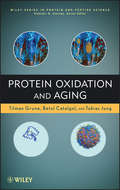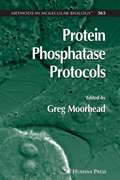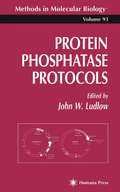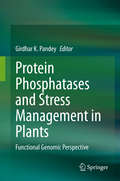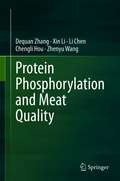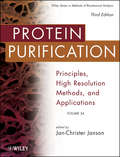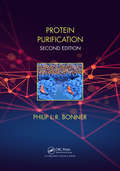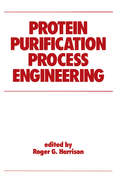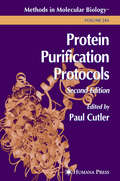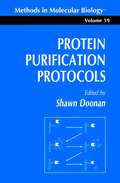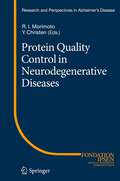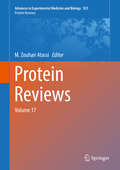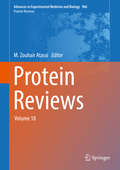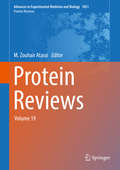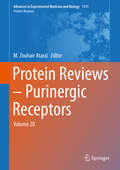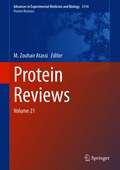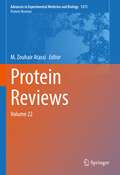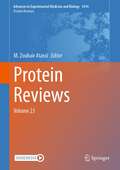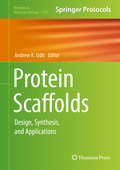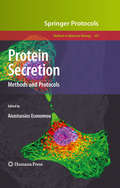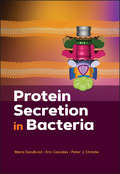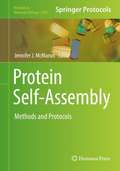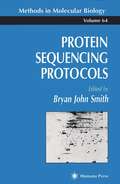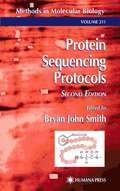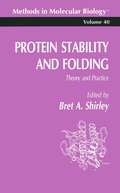- Table View
- List View
Protein Oxidation and Aging
by Vladimir Uversky Tilman Grune Tobias Jung Betul CatalgolReviews our current understanding of the role of protein oxidation in aging and age-related diseasesProtein oxidation is at the core of the aging process. Setting forth a variety of new methods and approaches, this book helps researchers conveniently by exploring the aging process and developing more effective therapies to prevent or treat age-related diseases. There have been many studies dedicated to the relationship between protein oxidation and age-related pathology; now it is possible for researchers and readers to learn new techniques as utilizing protein oxidation products as biomarkers for aging.Protein Oxidation and Aging begins with a description of the tremendous variety of protein oxidation products. Furthermore, it covers:Major aspects of the protein oxidation processCellular mechanisms for managing oxidized proteinsRole of protein oxidation in agingInfluence of genetic and environmental factors on protein oxidationMeasuring protein oxidation in the aging processProtein oxidation in age-related diseasesReferences at the end of each chapter serve as a gateway to the growing body of original research studies and reviews in the field.
Protein Phosphatase Protocols
by Greg MoorheadProtein Phosphatase Protocols presents a broad range of protocols for the study of protein phosphatases, all written by experts and innovators from phosphatase laboratories around the world. This volume is a compendium of resources for the study of protein phosphatases and their potential as drug targets. Experimental methodologies are taken from proteomics, bioinformatics, genomics, biochemistry, RNAi, and genetics.
Protein Phosphatase Protocols
by John W. LudlowCutting-edge techniques presented with foolproof, step-by-step instructions make this collection indispensable for investigating the structure and function of protein serine/threonine phosphatases. The book contains methods designed to enable the investigator to isolate, identify, and assay phosphatase activities from both prokaryotic and eukaryotic sources, and includes a discussion of the functional significance of this group of enzymes with respect to cell growth and development. Written by leaders with extensive practice in their use, each method is time-tested and sufficiently detailed to ensure reproducibility for both new and established investigators.
Protein Phosphatases and Stress Management in Plants: Functional Genomic Perspective
by Girdhar K. PandeyThe regulation of the phosphorylation/dephosphorylation process, resulting in “cellular switches” that monitor normal plant physiology, growth and development, has immense potential in crop systems. With much of the information in the nascent stages, coming largely from Arabidopsis and rice particularly, the use of cell biology, genetic screens, biochemical approaches aided by an omics approach should help unravel the detail functional information available about signaling pathways in plants. The regulation could be exploited to develop crop varieties better equipped to handle changing environments and enhance agricultural productivity. In the post-genomic era, one of the major challenges is investigation and understanding of multiple genes and gene families regulating a particular physiological and developmental aspect of plant life cycle. One of the important physiological processes is regulation of stress response, which leads to adaptation or adjustment in response to adverse stimuli. With the holistic understanding of the signaling pathways involving phosphatases, one gene family or multiple genes or gene families, plant biologist can lay a foundation for designing and generating future crops, which can withstand the higher degree of environmental stresses. Especially abiotic stresses, which are the major cause of crop loss throughout the world without losing crop yield and productivity.This book incorporates the contributions from leading plant biologists in the field of stress-mediated dephosphorylation by phosphatases as an important task to elucidate the aspects of stress signaling by functional genomic approaches.
Protein Phosphorylation and Meat Quality
by Xin Li Li Chen Zhenyu Wang Dequan Zhang Chengli HouThe book focuses on the current research of the relation between protein phosphorylation and meat quality, reviews the influence mechanism of protein phosphorylation on meat quality, and summarizes the improvement of meat quality by regulating protein phosphorylation. It could help to clarify some dilemmas and encourage further research in this field, aiming for effective application of protein phosphorylation in meat quality in the near future. The book is written for researchers and graduate students in the field of meat science, food chemistry and molecular biology etc.
Protein Purification
by Jan-Christer JansonThe authoritative guide on protein purification--now completely updated and revisedSince the Second Edition of Protein Purification was published in 1998, the sequencing of the human genome and other developments in bioscience have dramatically changed the landscape of protein research. This new edition addresses these developments, featuring a wealth of new topics and several chapters rewritten from scratch.Leading experts in the field cover all major biochemical separation methods for proteins in use today, providing professionals in biochemistry, organic chemistry, and analytical chemistry with quick access to the latest techniques. Entirely new or thoroughly revised content includes:High-resolution reversed-phase liquid chromatographyElectrophoresis in gelsConventional isoelectric focusing in gel slabs and capillaries and immobilized pH gradientsAffinity ligands from chemical and biological combinatorial librariesMembrane separationsRefolding of inclusion body proteins from E. coliPurification of PEGylated proteinsHigh throughput screening techniques in protein purificationThe history of protein chromatography
Protein Purification (THE BASICS (Garland Science))
by Philip BonnerThis second edition of Protein Purification provides a guide to the major chromatographic techniques, including non-affinity absorption techniques, affinity procedures, non-absorption techniques and methods for monitoring protein purity. The new edition of the book has been organized to encourage incremental learning about the topic, starting with the properties of water, progressing through the characteristics of amino acids and proteins which relate to the purification process. There is an overview of protein strategy and equipment, followed by discussions and examples of each technique and their applications. The basic theory and simple explanations given in Protein Purification make it an ideal handbook for final year undergraduates, and postgraduates, who are conducting research projects. It will also be a useful guide to more experienced researchers who need a good overview of the techniques and products used in protein purification. Key Features * Guide to the major techniques used in protein purification * Includes flowcharts to help the reader slect the best purification strategy * Contains step-by-step protocols that guide the reader through each technique and its use * Includes exercises and solutions
Protein Purification Process Engineering
by Roger G. HarrisonOffers coverage of the development of protein purification processes for large-scale commercial operations, and addresses process development, scale-up, applications and mathematical descriptions. Technologies currently used at the commercial scale are covered in depth.
Protein Purification Protocols
by Paul CutlerThis new edition of Protein Purification Protocols (1996) completely updates the existing protocols to reflect recent advances and adds the enormous new array of proteomic techniques for protein isolation and analysis. These cutting-edge techniques include not only two-dimensional gel electrophoresis for analysis and characterization, but also analytical chromatography for multidimensional separations of proteins and peptides, and mass spectrometry for isolating proteins.
Protein Purification Protocols
by Shawn DoonanA comprehensive collection of essential, time-tested recipes for successful protein fractionation and purification in any experimental circumstance. The protocols give step-by-step instructions on how to select a source for the protein of interest, how to obtain a usable initial extract, how to purify the protein from that extract using both chemical and molecular methods, and how to dry and store the purified protein. Protein Purification Protocols provides all that is needed to design and carry out a successful purification program. It helps both experienced and novice investigators to clarify and define their purification problems and then provides a comprehensive set of tools for a practical solution.
Protein Quality Control in Neurodegenerative Diseases
by Yves Christen Richard I. MorimotoThe health of the proteome depends upon protein quality control to regulate the proper synthesis, folding, translocation, and clearance of proteins. The cell is challenged constantly by environmental and physiological stress, aging, and the chronic expressions of disease associated misfolded proteins. Substantial evidence supports the hypothesis that the expression of damaged proteins initiates a cascade of molecular events that leads to Alzheimer's disease, Parkinson's disease, amyotrophic lateral sclerosis, Huntington's disease, and other diseases of protein conformation.
Protein Reviews
by M. Zouhair AtassiThis volume successfully and clearly examines how biophysical approaches can be used to study complex systems of reversibly interacting proteins. It deals with the methodology behind the research and shows how to synergistically incorporate several methodologies for use. Each chapter treats and introduces the reader to different biological systems, includes a brief summary of the physical principles, and mentions practical requirements.
Protein Reviews
by M. Zouhair AtassiThe aim of the Protein Reviews is to serve as a publication vehicle for review articles that focus on crucial current vigorous aspects of protein structure, function, evolution and genetics. Volume 17 of Protein Reviews is the beginning of a new publication format. The volumes will appear online before they are published in a printed book. Articles will be selected according to their importance to the understanding of biological systems, their relevance to the unravelling of issues associated with health and disease or their impact on scientific or technological advances and developments. The chapters in this volume are authored by experts in the field. They deal with aspects of structure and biological activity of selected proteins. Specific chapters deal with the aggregation of FET proteins (FUS, EWSR1, TAF15) as a pathological change in amyotrophic lateral sclerosis, structural changes fundamental to gating of the cystic fibrosis transmembrane conductance regulator anion channel pore, the dual roles for epithelial splicing regulatory proteins 1 (ESRP1) and 2 (ESRP2) in cancer progression, controlling autolysis during flagella insertion in Gram-negative bacteria, the regulation of skeletal muscle myoblast differentiation and the proliferation by pannexins, hyaluronidase and chondroitinase, factors that control mitotic spindle elongation, how secreted phospholipase A2 type IIA (sPLA2-IIA) activates integrins in an allosteric manner, the simple and unique allosteric machinery of Thermus caldophilus lactate dehydrogenase, and the reduction of chemically stable multibonds: Nitrogenase-like biosynthesis of tetrapyrroles. This volume is intended for research scientists, clinicians, physicians, and graduate students in fields of biochemistry, cell biology, molecular biology microbiology, immunology and genetics.
Protein Reviews
by M. Zouhair AtassiThe aim of the Protein Reviews is to serve as a publication vehicle for review articles that focus on crucial current vigorous aspects of protein structure, function, evolution and genetics. The volumes will appear online before they are published in a printed book. Articles are selected according to their importance to the understanding of biological systems, their relevance to the unravelling of issues associated with health and disease or their impact on scientific or technological advances and developments. The chapters in volume 18 are authored by experts in the field. They deal with aspects of structure and/or biological activity of selected proteins. The chapters review current research of the following topics: the Mechanism of channel gating and regulation of the activity of calcium-activated chloride channel ANO1, Structure and function of the two-component cytotoxins of Staphylococcus aureus, Membrane Fusion and Infection involving the influenza virus hemagglutinin, The impact of arrhythmogenic mutations through the structural determination of the L-type voltage-gated calcium channel, Discussion of some open questions pertaining to histone post-translational modifications and nucleosome organization in transcriptional regulation, Regulation of the extracellular SERPINA5 (protein C inhibitor) penetration through cellular membranes, Coding of Class I and II aminoacyl-tRNA synthetases, Nephrin phosphorylation in diabetes and chronic kidney injury, The structure-forming juncture in oxidative protein folding and the events in the ER, The polyspecificity of anti-lipid antibodies and its relevance to the development of autoimmunity. This volume is intended for research scientists, clinicians, physicians and graduate students in the fields of biochemistry, cell biology, molecular biology, immunology and genetics.
Protein Reviews – Purinergic Receptors: Volume 20 (Advances in Experimental Medicine and Biology #1111)
by M. Zouhair AtassiThe Protein Reviews series serves as a publication vehicle for reviews that focus on crucial contemporary and vital aspects of protein structure, function, evolution and genetics. Volume 20, Purinergic Receptors, has ten chapters. The first five chapters deal with various aspects of membrane binding. The first chapter focuses on the phox-homology (PX) domain, which is a phosphoinositide-binding domain conserved in all eukaryotes and present in forty-nine human proteins. The next chapter deals with the modeling of PH domains/phosphoinositides interactions. This is followed by a chapter on BAR domain proteins regulate Rho GTPase signaling. The BAR (Bin–Amphiphysin–Rvs) domain is a membrane lipid binding domain present in a wide variety of proteins, often proteins with a role in Rho-regulated signaling pathways. The fourth article presents AP180 N-terminal homology (ANTH) and Epsin N-terminal homology (ENTH) domains and discusses their physiological functions and involvement in disease. The fifth article reviews the polyphosphoinositide-binding domains and presents insights from peripheral membrane and lipid-transfer proteins. This is followed by a chapter on the physiological functions of phosphoinositide-modifying enzymes and their interacting proteins in Arabidopsis, then by a chapter on the molecular mechanisms of Vaspin action in various tissues such as adipose tissue, skin, bone, blood vessels, and the brain. The eighth chapter deals with exceptionally selective substrate targeting by the metalloprotease anthrax lethal factor followed by an article on Salmonella, E. coli, and Citrobacter type III secretion system effector proteins that alter host innate immunity. The last chapter presents New techniques to study intracellular receptors in living cells, with insights into RIG-I-like receptor signaling. Volume 20 is intended for research scientists, clinicians, physicians and graduate students in the fields of biochemistry, cell biology, molecular biology, immunology and genetics.
Protein Reviews: Volume 21 (Advances in Experimental Medicine and Biology #21)
by M. Zouhair AtassiThe Protein Reviews series serves as a publication vehicle for reviews that focus on crucial contemporary and vital aspects of protein structure, function, evolution and genetics. Volumes are published online first, prior to publication in a printed book. Chapters are selected according to their importance to the understanding of biological systems, relevance to the unravelling of issues associated with health and disease, or impact on scientific or technological advances and developments. Volume 21 presents eight review chapters authored by experts in the related fields. The first chapter covers the enzyme squalene monooxygenase and lipid levels and its relevance in health and disease. Chapter two presents a systematic analysis of the structural and functional aspects of heteromeric solute carriers. The third chapter provides a review of the role of CI- in type IV collagen assembly, function, and disease, including future directions for studies. This is followed by a summary in chapter four about the recent progress on defining the roles of the Slit-Robo signaling in bone metabolism and the possible roles of the interaction between Robo and neural epidermal growth factor-like proteins. Chapter five discusses recent data about the evolutionary aspects on structural differences between humans and the nematode in relation to previous knowledge of core proteins and GAG-attachment sites in Chn and CS proteoglycans of C.elegans and humans. The sixth chapter summarizes the immunochemical character of the IGHV1-69-derived RFs and the recognition mechanism of the IGHV1-69-derived RFs. Chapter seven covers regulated alternative translocation and its role as an emerging mechanism to regulate transmembrane proteins. Finally, chapter eight reviews current progress on IL-36 protein and biology and novel investigative tools. This volume is intended for research scientists, clinicians, physicians and graduate students in the fields of biochemistry, cell biology, molecular biology, immunology and genetics.
Protein Reviews: Volume 22 (Advances in Experimental Medicine and Biology #1371)
by M. Zouhair AtassiThe Protein Reviews series serves as a publication vehicle for reviews that focus on crucial contemporary and vital aspects of protein structure, function, evolution and genetics. Volumes are published online first, prior to publication in a printed book. Chapters are selected according to their importance to the understanding of biological systems, relevance to the unravelling of issues associated with health and disease, or impact on scientific or technological advances and developments. Volume 22 presents six review chapters authored by experts in related fields. The first chapter covers carotenoid-protein interactions. Chapter two addresses the non-continuum of eukaryotic transcriptional regulation. The third chapter reviews the structure of the regulatory and catalytic domains of the photoreceptor phosphodiesterase (PDE6) holoenzyme. Chapter four reviews the current knowledge on small molecule compounds that have been evaluated as rhodopsin modulators to be considered as leads for the development of novel therapies for retinitis pigmentosa. Chapter five deals with Plasticity-associated functionality and inhibition of the HIV protease. Finally, chapter six covers single-run catalysis and kinetic control of human telomerase holoenzyme. This volume is intended for research scientists, clinicians, physicians and graduate students in the fields of biochemistry, cell biology, molecular biology, immunology and genetics.
Protein Reviews: Volume 23 (Advances in Experimental Medicine and Biology #1414)
by M. Zouhair AtassiThe Protein Reviews series serves as a publication vehicle for reviews that focus on crucial contemporary and vital aspects of protein structure, function, evolution and genetics. Volumes are published online first, prior to publication in a printed book. Chapters are selected according to their importance to the understanding of biological systems, relevance to the unravelling of issues associated with health and disease, or impact on scientific or technological advances and developments. Volume 23 presents four review chapters authored by experts in related fields. The first chapter covers the structure and function of SNM1 family nucleases. Chapter two examines the molecular details of DNA integration by CRISPR-associated (Cas) proteins during adaptation in bacteria and archaea. The third chapter reviews the ordered motions in the nitric-oxide dioxygenase (NOD) mechanism of flavohemoglobin and assorted globins with tightly coupled reductases. Chapter four reviews structural analyses of the multicopper site of CopG support a role as a redox enzyme. This volume is intended for research scientists, clinicians, physicians and graduate students in the fields of biochemistry, cell biology, molecular biology, immunology and genetics.
Protein Scaffolds: Design, Synthesis, and Applications (Methods in Molecular Biology #1798)
by Andrew K. UditThis volume provides a wide range of methods and protocols detailing various protein structures as platforms for building architectures with targeted application. Chapters guide the readers through exploiting a number of protein scaffolds including virus nanoparticles, elastin and collagen peptides and proteins, and other protein templates for either building materials or presentation of ligands. Site-specific bioconjugation methods, some unique protein architectures, and techniques that exploit peptide amphiphile micelles and assembly of chaperones are also featured. Written in the highly successful Methods in Molecular Biology series format, chapters include introductions to their respective topics, lists of the necessary materials and reagents, step-by-step, readily reproducible laboratory protocols, and tips on troubleshooting and avoiding known pitfalls. Authoritative and cutting-edge, Protein Scaffolds: Design, Synthesis, and Applications aims to ensure successful results in the study of this vital field.
Protein Secretion
by Anastassios EconomouOver the past thirty years, many elegant genetic and biochemical approaches have been combined in order to advance the study of protein secretion and the necessary navigation through cell membranes, yet, despite this progress, less than two hundred membrane protein structures are known, nowhere near the complete inventory that the discovered protein export systems suggest. In Protein Secretion: Methods and Protocols, leading experts in the field provide robust, well-established protocols to elucidate the multiplicity of tools that have been developed to study protein sorting, membrane targeting, transmembrane crossing, and secretion across multiple membranes. With examples involving both prokaryotic and eukaryotic organisms, the volume covers subjects ranging from bioinformatics and proteomics to fundamental enzymology and genetics to cell biology, structural analyses, and biophysics. Written in the highly successful Methods in Molecular BiologyTM series format, chapters contain introductions to their respective topics, lists of the key materials and reagents, step-by-step, readily reproducible protocols, and detailed notes on troubleshooting and avoiding known pitfalls. Comprehensive and dependable, Protein Secretion: Methods and Protocols focuses on well-characterized paradigms so that scientists studying a vast array of subjects from biochemistry and genetics to biotechnology and biopharmaceuticals can benefit and expand upon their vital research.
Protein Secretion in Bacteria (ASM Books)
by Eric Cascales Peter Christie Maria SandkvistProtein transport into and across membranes is a fundamental process in bacteria that touches upon and unites many areas of microbiology, including bacterial cell physiology, adhesion and motility, nutrient scavenging, intrabacterial signaling and social behavior, toxin deployment, interbacterial antagonism and collaboration, host invasion and disruption, and immune evasion. A broad repertoire of mechanisms and macromolecular machines are required to deliver protein substrates across bacterial cell membranes for intended effects. Some machines are common to most, if not all bacteria, whereas others are specific to Gram-negative or Gram-positive species or species with unique cell envelope properties such as members of Actinobacteria and Spirochetes. Protein Secretion in Bacteria, authored and edited by an international team of experts, draws together the many distinct functions and mechanisms involved in protein translocation in one concise tome. This comprehensive book presents updated information on all aspects of bacterial protein secretion encompassing: Individual secretory systems–Sec, Tat, and T1SS through the newly discovered T9SS Mechanisms, structures, and functions of bacterial secretion systems Lipoprotein sorting pathways, outer membrane vesicles, and the sortase system Structures and roles of surface organelles, including flagella, pili, and curli Emerging technologies and translational implications Protein Secretion in Bacteria serves as both an introductory guide for students and postdocs and a ready reference for seasoned researchers whose work touches on protein export and secretion. This volume synthesizes the diversity of mechanisms of bacterial secretion across the microbial world into a digestible resource to stimulate new research, inspire continued identification and characterization of novel systems, and bring about new ways to manipulate these systems for biotechnological, preventative, and therapeutic applications.
Protein Self-Assembly: Methods and Protocols (Methods in Molecular Biology #2039)
by Jennifer J. McManusThis volume explores experimental and computational approaches to measuring the most widely studied protein assemblies, including condensed liquid phases, aggregates, and crystals. The chapters in this book are organized into three parts: Part One looks at the techniques used to measure protein-protein interactions and equilibrium protein phases in dilute and concentrated protein solutions; Part Two describes methods to measure kinetics of aggregation and to characterize the assembled state; and Part Three details several different computational approaches that are currently used to help researchers understand protein self-assembly. Written in the highly successful Methods in Molecular Biology series format, chapters include introductions to their respective topics, lists of the necessary materials and reagents, step-by-step, readily reproducible laboratory protocols, and tips on troubleshooting and avoiding known pitfalls.Thorough and cutting-edge, Protein Self-Assembly: Methods and Protocols is a valuable resource for researchers who are interested in learning more about this developing field.
Protein Sequencing Protocols
by Bryan John SmithBryan Smith draws together in Protein Sequencing Protocols a timely collection of current and state-of-the-art techniques for protein and peptide preparation and sequencing-all described by hands-on masters of the procedures. These well-tested methods convey valuable lessons and insights into using automated sequencers and/or mass spectrometers, preparing proteins and peptides on a microgram and submicrogram scale, mapping peptides, analyzing amino acid by pre- and post-column derivatization methods, and sequencing N- and C-terminal peptides by classical and newly developed techniques. They also deal with such troublesome problems as identifying sites of modification and handling very small samples.<P><P> Protein Sequencing Protocols offers self-contained, step-by-step recipes that ensure easily reproducible results for those already doing sequencing, and for those who are still learning the methods, as well as for those already in one area but wishing to learn associated techniques. Its multiplicity of proven protocols will guide the challenged experimenter to successful results.
Protein Sequencing Protocols, 2nd Edition
by Bryan John SmithBryan John Smith updates his much-acclaimed first edition with new and updated techniques for determining the sequence of proteins and peptides. This edition includes not only novel approaches to the validation of quality assurance methods, reflecting the current importance of biopharmaceuticals, but also offers a guide to analysis of protein sequence information via the powerful new tools of bioinformatics. Comprehensive and up-to-date, Protein Sequencing Protocols, Second Edition, provides for both novice and expert investigators alike a ready source of easy-to-follow protocols that simplify choosing the most appropriate method for protein sequence determination.
Protein Stability and Folding
by Bret A. ShirleyIn Protein Stability and Folding: Theory and Practice, world-class scientists present in a single volume a comprehensive selection of hands-on recipes for all of the major techniques needed to understand the conformational stability of proteins, as well as their three-dimensional folding. The distinguished contributors provide clear, step-by-step instructions along with many troubleshooting tips, alternative procedures, and informative explanations about why certain steps are necessary. Even highly skilled researchers will find many time-saving methods. Among the techniques discussed are fluorescent, ultraviolet, and infrared spectroscopy; HPLC peptide mapping; differential scanning calorimetry; and hydrogen exchange. Shirley's Protein Stability and Folding: Theory and Practice will ensure a significant difference in the outcome of your experiments, producing the result desired even for beginners.
